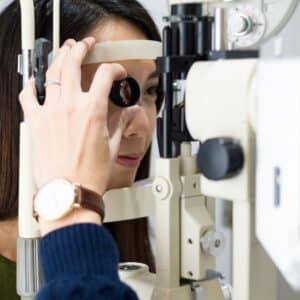What is Farsightedness?
Farsightedness, also known as hyperopia, is a common refractive error of the eye in which distant objects are seen more clearly than nearby objects. This condition occurs when the eyeball is shorter than it should be or when the cornea (the clear front part of the eye) is not curved enough. As a result, light entering the eye is not focused correctly onto the retina, which is the light-sensitive tissue at the back of the eye, causing images of nearby objects to appear blurry.
Farsightedness is a common condition that affects people of all ages, from children to seniors. It is estimated that about 5-10% of people in the United States have some degree of farsightedness. The severity of farsightedness varies among individuals and can range from mild to severe.
Farsightedness and nearsightedness are types of refractive errors, which means that they affect how light is refracted or bent as it enters the eye. Farsightedness differs from nearsightedness (myopia), a condition where distant objects appear blurry while nearby objects are clear. In both cases, treatment aims to correct the refractive error and improve vision.
Causes of Farsightedness
The eye shape usually causes farsightedness, but certain health conditions can also cause it. Some of the most common causes of farsightedness include:
- Genetics: Farsightedness can run in families, suggesting that genetics may play a role in its development.
- Eye shape: Farsightedness is often caused by an eye shape that is too short, causing the light to focus behind the retina. This can be due to genetic factors or may be related to the aging process.
- Age: Farsightedness can develop as a natural part of the aging process. As we age, the eye’s lens becomes less flexible and loses its ability to change shape, making it more difficult to focus on objects up close.
- Medical conditions: Certain conditions, such as diabetes or multiple sclerosis, can affect the eyes and cause farsightedness.
- Medications: Some medications, such as antidepressants or antihistamines, can cause or worsen farsightedness.
- Eye injuries or surgeries: Trauma to the eye or certain types of eye surgeries can affect the shape of the eye and cause farsightedness.
Symptoms of Farsightedness
Farsightedness can cause a range of symptoms, including:
- Blurry vision when looking at objects up close: One of the most common symptoms of farsightedness is difficulty seeing objects that are close to the eyes, such as reading material, phone screens, or computer screens. This can result in blurry or fuzzy vision and cause eye strain or fatigue.
- Difficulty reading or doing close work: Farsightedness can make it difficult to focus on small print or detailed tasks that require visual acuity, such as reading, writing, sewing, or using a computer. This may cause discomfort or frustration and make tasks take longer.
- Eye strain or fatigue when doing close work: Focusing on objects up close can strain the eyes, causing them to feel tired, sore, or achy. This can be especially noticeable after extended reading or computer use periods and may lead to headaches or other discomforts.
- Headaches: Farsightedness can cause headaches, especially when doing close work for extended periods. These headaches may be mild or severe and may be accompanied by other symptoms such as eye strain or fatigue.
Diagnosis of Farsightedness
Farsightedness can be diagnosed during a comprehensive eye exam, which includes several tests to measure vision and eye health. The most common tests for farsightedness include:
- Visual acuity test: Using an eye chart, this test measures how well a person can see at different distances.
- Refraction test: This test measures the eye’s ability to focus light and helps determine the correct prescription for glasses or contact lenses.
- Eye health evaluation: This test involves examining the eye’s structures and checking for signs of eye diseases or other abnormalities.
Treatment for Farsightedness
Farsightedness can be corrected with glasses, contact lenses, or surgery. The most common treatments for farsightedness include:
- Reading glasses: Reading glasses are a type of eyeglasses that are designed specifically for reading or doing close work.
- Eyeglasses: Prescription eyeglasses can correct farsightedness by using lenses that are thicker in the center and thinner at the edges. This design helps to refract light more effectively and bring it into focus on the retina. Glasses are a simple and effective treatment option for many people with farsightedness.
- Contact lenses: Like eyeglasses, contact lenses can also correct farsightedness. Contact lenses fit directly over the cornea and refract light more effectively. They can be a good option for people who don’t like the look of glasses or who have an active lifestyle.
- Refractive surgery: In some cases, refractive surgery may be recommended to correct farsightedness. The most common types of refractive surgery include LASIK, PRK, and LASEK. These surgeries use lasers to reshape the cornea and correct refractive errors. They can effectively reduce or eliminate the need for glasses or contact lenses, but they also carry some risks and potential side effects.
- Reading glasses: Some people with farsightedness may only need glasses for reading or close work. Reading glasses are designed to magnify close-up objects and can be a good option for people with trouble seeing small print or doing detailed work.
- Multifocal lenses: For people with farsightedness and presbyopia (age-related nearsightedness), multifocal lenses can be a good option. These lenses have different power zones allowing clear vision at different distances.
It is essential to consult with an optometrist or ophthalmologist to determine the best treatment option for your individual needs. Farsightedness is a common and treatable condition, and with the proper treatment, most people with farsightedness can achieve a clear, comfortable vision.
Prevention of Farsightedness
While farsightedness cannot be prevented, there are several steps that people can take to reduce their risk of developing the condition. These include:
- Having regular eye exams: Regular eye exams can help detect farsightedness and other eye problems early when they are easier to treat.
- Wearing protective eyewear: Protective eyewear, such as safety glasses, can help prevent eye injuries that can lead to farsightedness.
- Taking breaks from close work: Taking regular breaks when doing close work, such as reading or using a computer, can help reduce eye strain and fatigue.
- Using proper lighting: Using adequate lighting when doing close work can help reduce eye strain and prevent the development of farsightedness.
- Maintaining a healthy lifestyle: Eating a balanced diet, exercising regularly, and avoiding smoking can help maintain overall eye health.
Conclusion
Farsightedness is a common eye condition that can affect people of all ages. It is caused by the eye’s shape or certain health conditions and can cause various symptoms, such as blurry vision and eye strain.
Farsightedness can be diagnosed through a comprehensive eye exam and treated with eyeglasses, contact lenses, or surgery. If you are experiencing symptoms of farsightedness, it is essential to schedule an appointment with an eye doctor to determine the cause and appropriate treatment options. While farsightedness cannot be prevented, maintaining overall eye health can help reduce the risk of developing the condition.






